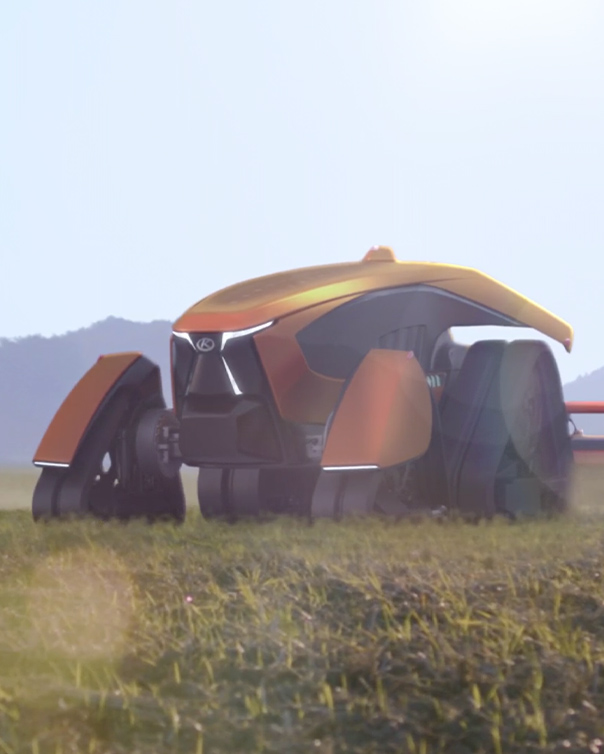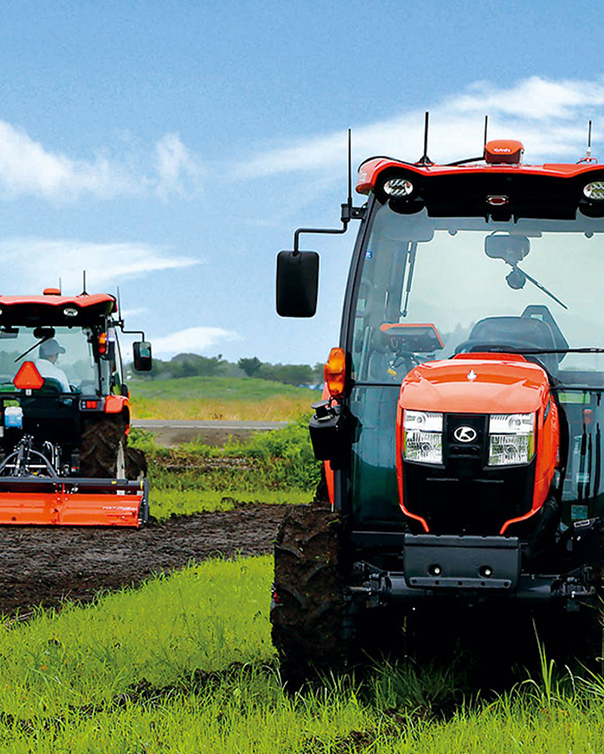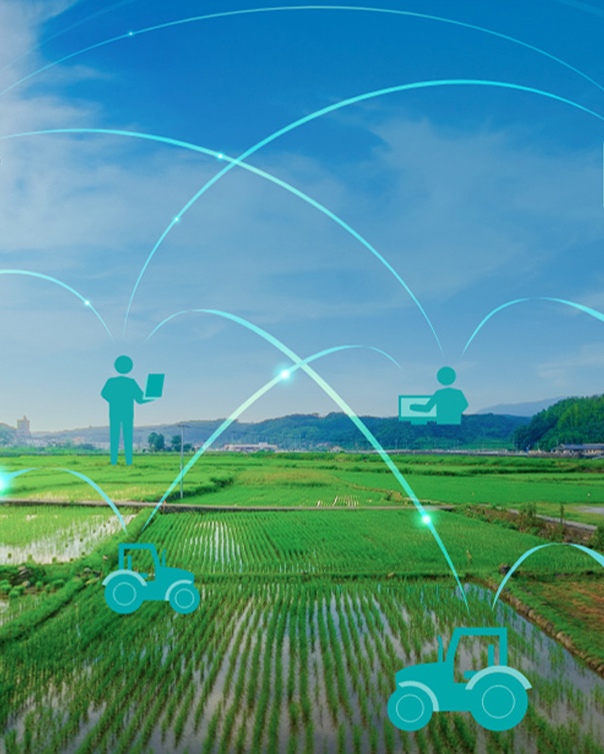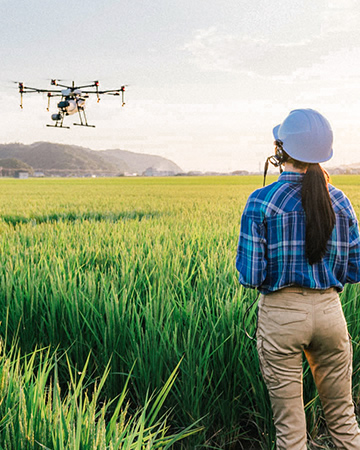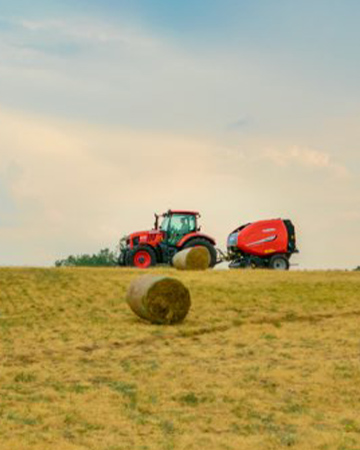
ICT has made tremendous advancements in recent years. As companies of all sorts are facing the need to support the newest developments in ICT, Kubota has launched its new Global ICT Headquarters (hereafter, G-ICT) and is aiming to achieve its digital transformation with the goal of creating new solutions. And in March 2020, Kubota announced a strategic alliance with Microsoft Corporation, setting the stage for its full-scale digital transformation.
What sorts of innovations does Kubota seek to achieve through this transformation? This article will introduce Kubota’s digital transformation strategy and explore its specific objectives and the initiatives it is taking on now.
Kubota’s Digital Transformation Takes On Advancing Global Issues
Digital transformation is generally defined as the use of cloud computing, big data, and other technologies by companies to create new products, services, and business models and establish competitive advantage. The ICT related to this field is advancing rapidly, opening new possibilities for industry.
As these digital technologies progress and become more widely used, Kubota has been putting them to use and creating a variety of solutions in Japan. One is KSAS (KUBOTA Smart Agriculture System), a farming management and service support system that integrates agricultural machinery and ICT. Another is KSIS (KUBOTA Smart Infrastructure System), a service that utilizes automated agricultural machinery and IoT in water and environmental management. Kubota is providing unique technologies, products, and services to address issues in the fields of food, water, and the environment.

Global issues related to food, water, and the environment are expected to become more severe and diverse in the future as the world’s population increases and global warming intensifies. At Kubota, solving these growing global issues is its mission, and thus digital transformation has become a necessity.
Kubota integrated the IT departments of each of its business divisions and established a new G-ICT Headquarters. This builds a digital transformation platform and proactively utilizes big data, AI and other cutting-edge technologies while speeding up decision-making and action in order to create new customer value and maximize this value. This is the digital vision that Kubota aims to achieve by 2025, and the company’s strategic partnership with Microsoft marked a major step in this direction.


A Cloud-First Strategy for Improving Productivity
Kubota will take advantage of this strategic alliance to accelerate its digital transformation by utilizing Microsoft’s service infrastructure in multifaceted ways. One is the full migration of its IT infrastructure and other core systems to Microsoft Azure, the highly secure cloud service. This will make it easier to use AI and other advanced technologies and enable the deployment of data on a global scale. The integration of core systems on the cloud and utilization of a range of IT technologies will also streamline operations and improve productivity.
Yoshizo Furuya of the G-ICT explains the digital transformation’s potential: “Kubota has always conducted its business from the customer’s perspective. That’s why it is crucial for us to understand how our customers are using Kubota products. For example, if we can aggregate data on agricultural and construction machinery operations, harvested crops, and other facets of farm management into the cloud using IoT and visualize and analyze that data, it could lead to the development of new products that are more attuned to the challenges customers face. And if we could combine this with the information in inquiries we receive from customers, we could respond to product quality issues more quickly.”
Aggregating data into the cloud also frees employees from the tasks of individual data entry work. This can streamline business processes, giving us more time to focus on creating as many new solutions as possible.

Aiming to Provide New Value through Proactive Utilization of AI
Microsoft has expertise in AI, having worked with companies in a wide range of industries; Kubota has the knowledge it has gained through its businesses solving problems in food, water, and the environment. By integrating both companies’ strengths at a higher level, only then can a tremendous synergy be achieved.
Atsuhiko Saito of the G-ICT says this about the new possibilities in AI utilization: “There are surely things that AI can do that people cannot. For example, Kubota has a group of businesses that support water infrastructure, from upstream to downstream. These produce vast amounts of diverse data, but if AI can collect and analyze this data and connect it to our business activities, we may be able to provide even more relevant solutions than before, instantly.”

Kubota has already launched is AI Machine Learning Lab project with the purpose of accelerating innovations through AI applications. As this project’s initiatives continue to move forward, Furuya envisions the future prospects of AI utilization. “One initiative in this project is an AI-based image diagnostic program that began at our Sakai Plant. This uses AI to perform real-time analysis and automatic inspection of products that used to be inspected by workers, using images from cameras placed on the plant’s production line. Another initiative is designed to improve product quality. We have reached the point where AI can analyze details of repair requests brought to Kubota dealers and quickly provide information that is useful for quality improvement. I hope we can find new ways to use AI that are directly connected to solving problems in the food, water, and environmental fields.”
Driving the Digital Transformation Throughout the Group
Through its digital transformation, Kubota is working to innovate its products and services at levels never previously reached. At the same time, the rapid shift to ICT requires a steady commitment of internal education. As the G-ICT leads the way, what steps will it take to promote ICT as an initiative throughout the Kubota Group?
“When the G-ICT was established, there was a general perception at Kubota that IT was used to build business systems,” explains Furuya. “However, IT had not yet been implemented in our offices. That’s why we stepped away from the converting business systems to IT and started by working on proliferating use of smartphones and tablets within the company, digitization of workflows, and other efforts. We thought it was important to raise awareness within the company through a series of operational improvements that would make IT more familiar to every employee. This background also helped us make a smoother transition to telework and remote meetings during the Covid-19 pandemic, and this has instantly accelerated the smart transition of our internal operations.”
“The ultimate goal is to improve productivity through the use of AI and other technologies,” continues Furuya. “But our efforts have just begun. A mountain of issues remains.” As he says, the digital transformation cannot be realized in a single stride. Perhaps the best way to get there is to set the course for employees and raise the level of IT literacy throughout the group.

At Kubota, the goal is use globally-integrated and wide-ranging data to accelerate innovation and transform the company into a solutions-providing business. Its efforts in this transformation have just begun, but having forged this strong partnership with Microsoft, there is no doubt that Kubota has taken a step closer toward its realization.

